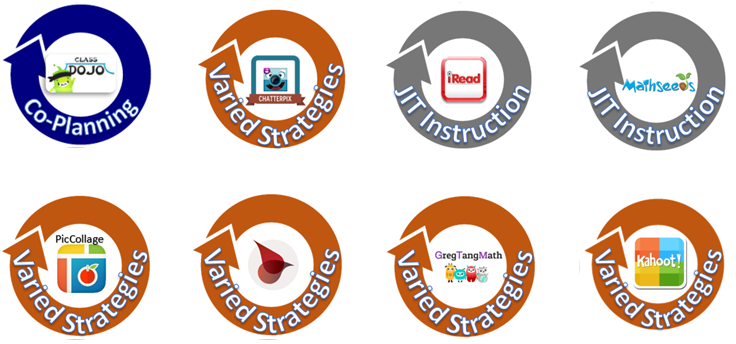Ideas for Starting a Badging Program at the School Level
KENNESAW, Ga. (Mar 27, 2018) — Getting teachers to try new technology can be hard. However, implementing a badging program along with incentives is a great way to spark interest for reluctant teachers. While not everyone is driven by the idea of earning a badge or working for that free Starbucks gift card, this can help improve motivation and get more teachers on board.
Getting Started
Starting a badging program takes time. It is important to have a support system, like the administration (Principal, Assistant Principal, etc.), to back you up. You will want to take time to plan out your school’s badging program so that you will not have hiccups when you are ready to start.
Here are some logistics you will want to work out ahead of time:
- Purpose
- Getting to the WHY of your badging program
- Making it meaningful
- Aligning your badging program with school goals or a personalized learning plan
- What will the badges look like?
- How will you create the badges?
- Will they be digital or paper (or both)?
- How many badges do you expect teachers to earn
- Can badges be built upon?
- How will teachers earn badges?
- Evidence
- Social Media (Twitter, Facebook, etc.)
- What incentives will you provide?
- Monetary
- Non-Monetary
- Create Infographics/Newsletters to introduce the badging system
- Meet with a focus group of lead teachers and other administration to get feedback
about the program.
- Create a list of pros and cons from your meeting
- Include a reason for the importance of teacher buy-in by encouraging them to be a part of the badging program
- Introduce the badging system to the school
- Faculty Meeting
- Digital Newsletter/Infographic
- Printed poster in Teacher Lounge
- Video/Stop Motion Animation
In the end, the more planning you get get done ahead of time, the smoother the implementation will go. You can even try piloting the program with one grade-level to see if a badging system would be a great fit for your school.
Showcasing Paper vs. Digital Badges
There are many pros and cons between doing paper badges and going digital with them. Deciding on the route to take will depend on your school and how you are wanting to display the badges. Some like to have them displayed within the school itself so that all stakeholders can see them when they enter a school. An elementary school I support chose to have them displayed outside each teacher’s door. In the beginning this created some hesitation from the teachers. But when the program started, they quickly saw this method as a way to see easily what other teachers were using in the classroom. Seeing the badges outside each teachers’ door opened the channels for discussion and collaboration about the technology tools they were using in the classroom. A sample of where teachers would display their badges is shown here on this toolbox. It was sized to a standard sheet of paper and laminated before hung outside the teacher’s classroom door.

To help the ease of using paper badges, having them printed on sticker labels allows for teachers to easily post them on a poster outside of their classroom. Here is an example of some printed badges on Avery circle sticker labels and the poster teachers can use outside of their classroom to house and showcase their earned badges.

If you decide to go the digital route, there are many programs out there that allow you to easily create badges and have teachers create an account to get their badges. One in particular is Credly. With Credly, you can create, issue, and manage digital credentials for your school. Another resource that I have found to be useful in conjunction with paper badges is Flippity. This site has some great resources including a way to create a badge tracker. This site has demos, instructions, and templates to use to help you get started and keep track of your badging system. If you use digital badges, teachers can also add them to their own class websites, email signatures, and/or class newsletters too.
Earning Badges
There are many different ways you can have teachers show evidence to earn a badge. Taking into account of the number of teachers participating, school’s social media presence, and number of people helping with giving out badges will all determine the best platform for your school. Some ideas include:
- Email: Have teachers email in their pictures or videos showcasing how they are using a tool in the classroom.
- Website: Set up a Weebly website to allow teachers to submit their evidence.
- Online Form: Set up a Google Form or other online form to allow teachers to submit their evidence.
- Social Media: Have teachers post to the school’s social media pages (ie: Facebook, Twitter, etc.) showing them using the tool in the classroom as their evidence. If you decide to use Twitter, you can create a unique hashtag to have teachers post with. This will make it easier to search and see postings specific for your badging program. At a school I am currently supporting, they are using #BESTools, a combination of the school’s name and the word “Tools” to create their hashtag so that teachers can use it when posting the different tools they are using in the classroom. You can always come up with a hashtag and then search Twitter to see if it is already being used or if you need to tweak it any.
Incentives
When deciding on the types of incentives to offer, it is important to know that not all incentives require money. Of course it is always nice to have gift cards or free food for your teachers. Here are some ideas of both monetary and non-monetary incentives to think about for your badging program.
- Monetary
- $5 gift cards (Starbucks, Restaurants, Grocery, Target, etc.)
- $10 gift cards (iTunes, Amazon, Netflix, etc.
- Cater Lunch/Breakfast
- Snacks
- Sweet Treats (cookies, brownies, cake during lunch, etc.)
- Provide opportunities to send teachers to Technology Training, Conferences, or
- Workshops (This would be a big prize incentive).
- Non-Monetary
- Administration (Principal, Assistant Principal, etc.) covers a teacher’s recess
- Administration covers morning or afternoon carpool/bus duty
- First to sign up for computer labs
- Tech Coach for a day (Some schools have a Technology Coach, Literacy Coach,
- Personalized Learning Coach, etc. at their schools that could come in and co-teach for the day).
- Leave 30 mins early (Most schools require teachers to work up to an hour after students leave for the day. A teacher could leave 30 mins early after that time.)
In the end, starting a badging program at the school level can be a great way to get teachers to collaborate and increase motivation to use technology in the classroom. Planning on the front end will help keep the “glitches” at a minimum and providing support to teachers to learn new tools will help keep the program going. Teachers will then be able to find and use tools to help them keep lessons engaging and make learning meaningful for all students.

Michelle Hague
Instructional Technology Specialist
iTeach @ Kennesaw State University
@KSUHague
















